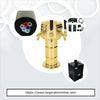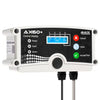Draft beer enthusiasts understand that a perfectly poured pint is a thing of beauty. While the quality of the beer itself plays a crucial role, the cooling and dispensing equipment is equally important. In this blog post, we will dive into the world of draft beer cooling and dispensing equipment, exploring the key components and their significance in delivering that refreshing, ice-cold pint of beer.
1. Draft Beer Cooling Systems:
a. Glycol Cooling Systems: Glycol cooling systems are the gold standard for maintaining the ideal serving temperature for draft beer. By using a mixture of water and propylene glycol, these systems ensure that the beer lines are chilled from keg to tap, preserving the flavors and aromas of the beer.
b. Direct Cooling Systems: Direct cooling systems, also known as air-cooled systems, use forced air to cool the beer lines. While they are more straightforward to install and maintain, they may not be as effective as glycol systems in long draw beer systems or situations with elevated ambient temperatures.
2. Keg Refrigeration:
a. Kegerators: Kegerators are self-contained refrigerators specially designed for storing and dispensing draft beer. These versatile units come in various sizes and can hold one or multiple kegs, providing a controlled cooling environment for the beer.
b. Walk-In Coolers: Walk-in coolers are commonly used in bars and restaurants with high beer consumption. These larger refrigerated rooms can store multiple kegs, keeping them at the perfect temperature and allowing for efficient rotation and storage of inventory.
3. Beer Dispensing Equipment:
a. Tap Towers: Tap towers are the visible centerpiece of any draft system, consisting of multiple taps positioned vertically or horizontally. They not only provide a convenient way to dispense beer but also enhance the aesthetic appeal of a bar or restaurant.
b. Faucets: Faucets play a vital role in delivering a smooth, controlled flow of beer from the keg to the glass. They come in various designs, including standard faucets, European-style faucets, and even specialized options like flow control faucets for precise pouring.
c. CO2 Regulators: CO2 regulators are essential for maintaining the correct carbonation levels in the beer. These devices control the flow of carbon dioxide from the gas cylinder to the keg, ensuring the beer retains the desired level of carbonation.
4. Cleaning and Maintenance:
a. Beer Line Cleaning Kits: Regular cleaning of beer lines is crucial to prevent the buildup of bacteria, yeast, and other contaminants that can negatively impact the taste and quality of the beer. Beer line cleaning kits provide the necessary tools and chemicals to effectively clean the lines.
b. Maintenance Tips: Proper maintenance of draft beer equipment involves regular inspection, cleaning, and replacing worn-out parts. This ensures optimal performance and extends the lifespan of the equipment.
Draft beer cooling and dispensing equipment form the backbone of a high-quality beer drinking experience. From glycol cooling systems to kegerators, tap towers to CO2 regulators, understanding the importance of these components allows establishments to serve the perfect pint, tantalizing beer lovers' taste buds. By investing in the right equipment and following proper maintenance protocols, bars, restaurants, and beer enthusiasts can unlock the secrets to consistently great-tasting draft beer. Cheers!
← Older Post Newer Post →










